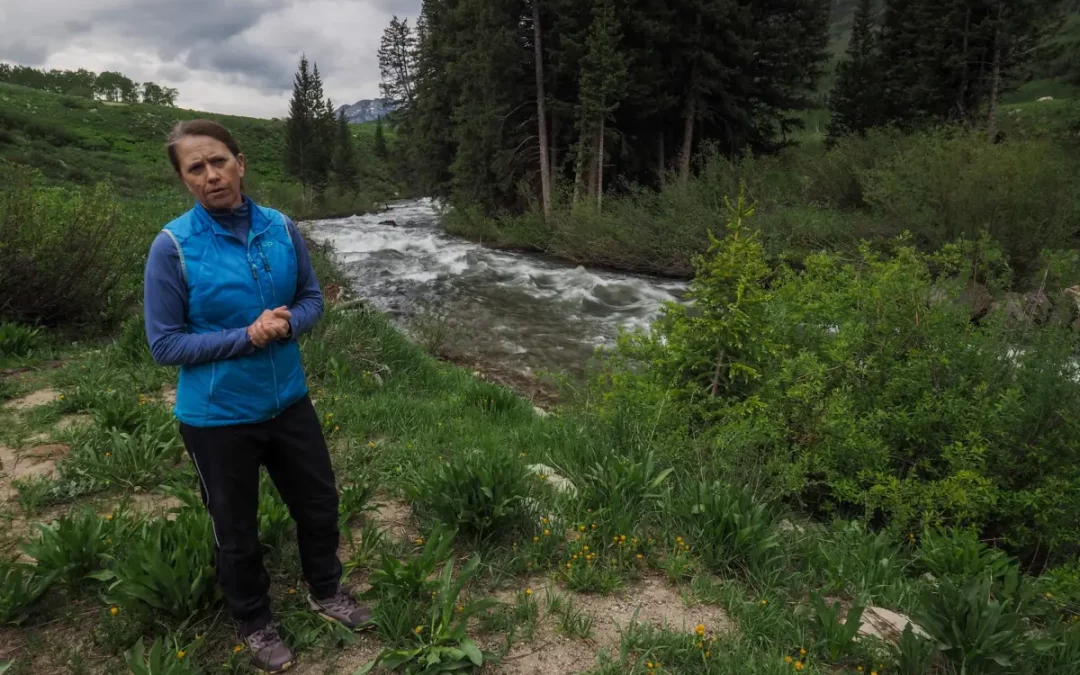A research study in the East River Basin, a small, mountainous river basin in western Colorado, shows that groundwater will fall in a warming climate — and it can take streams down with it.
These streams, including the East River, carry water from their headwaters through tunnels, canals and pipes to homes, farms and businesses in the overstressed Colorado River Basin. Groundwater’s role in this process has often been overlooked: Most of the water in Colorado’s mountain streams comes from snowpack, and without a lot of data, it’s been assumed that groundwater is not really a huge player.
That’s not the case, said Rosemary Carroll, the lead researcher on a groundwater study published in May in the academic journal, Nature Water.
“Groundwater is there to buffer your dry water years,” Carroll said. “If you had no groundwater, you would have a system go dry.”
The East River Basin covers about 115 square miles near Crested Butte. The river eventually flows into the Gunnison River, which meets the Colorado River in Grand Junction. It’s also where scientists have been gathering environmental data for a century through institutions like the Lawrence Berkeley National Laboratory and the Rocky Mountain Biological Laboratory.
Carroll is one of those scientists. As a Colorado-based researcher for the Desert Research Institute of Nevada, she has spent months digitally mapping the East River Basin into 100-meter squares, each extending deep underground, to study how climate change impacts the water stored under our feet.
Carroll and a team of researchers found that, on average, 75% of the streamflow in the basin comes from snow and rain, while 25% of the streamflow comes from groundwater. It’s an important water source, especially in the late summer and winter when the rivers are no longer flush with melting snow.
The groundwater — stored in the cracks in rock and spaces between soil and sand — acts as a buffer: in a dry water year, it might make up 50% of the stream flow, and during a wet water year, it might be 15% of the flow because there is more snowmelt.

Without it, there would be more ephemeral streams, which dry up periodically during the year. Flows into reservoirs would change, impacting the ecosystems and human uses that rely on releases of stored water.
The researchers wanted to see how groundwater would respond to warming temperatures. Already, Colorado’s average yearly temperature has increased 2 degrees Fahrenheit in the past 30 years. They cranked up the temperature to match projected warming over the next century: almost 8 degrees of additional warming.
They found that groundwater storage would fall to the lowest known levels after the first extremely dry year — like 2002 — and fail to recover even after multiple wet periods.
“It gets lower than it was simulated to occur historically, and it never can come back,” Carroll said. “It kind of unravels. It can’t get back.”
And when groundwater levels fall, water that would have flowed into streams could drop down into the water table below ground instead of contributing to Colorado River flows.
That could be one of many factors, like evaporation and thirsty soils, that caused a conundrum in 2021: Colorado, along with other states in the Colorado River’s Upper Basin, saw 80% of their normal snowpack, but once spring runoff started, they only saw 30% of the average flows in their streams and rivers, the study said.

Observing snowpack and predicting the resulting runoff is vital to water officials around the 246,000-square-mile river basin as they take stock of water supplies each year.
Warming temperatures are pushing the Colorado River Basin into unknown territory, John Overpeck, an environmental science professor at the University of Michigan, told attendees at a water law conference at the University of Colorado in early June.
In dry years and long drought periods, there is less incoming precipitation to recharge groundwater aquifers and to counteract the impacts of warming temperatures, like thirstier plants that suck water out of the ground and release it into the atmosphere.
The Colorado River Basin is megadrought country, Overpeck said, based on centuries of historical records. Research shows one megadrought lasted 80 years; the current megadrought started in 2000.
“We haven’t, as climate scientists, thought as carefully about groundwater as we should,” Overpeck said. “We’re depleting the groundwater, but Mother Nature is also depleting the groundwater because of what we’re doing with greenhouse gases.”
One main takeaway, Carroll said, is that scientists need to take groundwater levels into consideration as they analyze water issues in the Colorado River Basin. If they don’t, their predictions might be rosier than reality.
Streams that receive groundwater will receive less as water table elevations go down. Because the study accounted for groundwater, it accounted for those losses. Otherwise, it would predict more water in streams than would happen.
“I’m an optimistic person,” Carroll said, “but it’s like, OK, it’s going to be worse than you think.”



 Print
Print